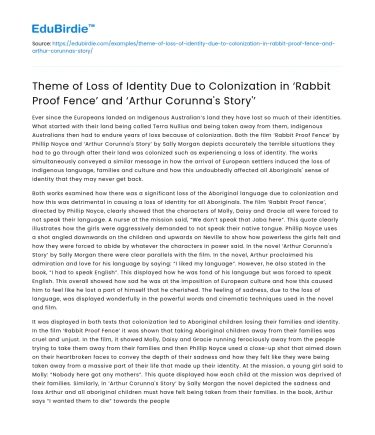Ever since the Europeans landed on Indigenous Australian’s land they have lost so much of their identities. What started with their land being called Terra Nullius and being taken away from them, Indigenous Australians then had to endure years of loss because of colonization. Both the film ‘Rabbit Proof Fence’ by Phillip Noyce and ‘Arthur Corunna's Story’ by Sally Morgan depicts accurately the terrible situations they had to go through after their land was colonized such as experiencing a loss of identity. The works simultaneously conveyed a similar message in how the arrival of European settlers induced the loss of Indigenous language, families and culture and how this undoubtedly affected all Aboriginals' sense of identity that they may never get back.
Both works examined how there was a significant loss of the Aboriginal language due to colonization and how this was detrimental in causing a loss of identity for all Aboriginals. The film ‘Rabbit Proof Fence’, directed by Phillip Noyce, clearly showed that the characters of Molly, Daisy and Gracie all were forced to not speak their language. A nurse at the mission said, “We don’t speak that Jaba here”. This quote clearly illustrates how the girls were aggressively demanded to not speak their native tongue. Phillip Noyce uses a shot angled downwards on the children and upwards on Neville to show how powerless the girls felt and how they were forced to abide by whatever the characters in power said. In the novel ‘Arthur Corunna's Story’ by Sally Morgan there were clear parallels with the film. In the novel, Arthur proclaimed his admiration and love for his language by saying: “I liked my language”. However, he also stated in the book, “I had to speak English”. This displayed how he was fond of his language but was forced to speak English. This overall showed how sad he was at the imposition of European culture and how this caused him to feel like he lost a part of himself that he cherished. The feeling of sadness, due to the loss of language, was displayed wonderfully in the powerful words and cinematic techniques used in the novel and film.
Save your time!
We can take care of your essay
- Proper editing and formatting
- Free revision, title page, and bibliography
- Flexible prices and money-back guarantee
It was displayed in both texts that colonization led to Aboriginal children losing their families and identity. In the film ‘Rabbit Proof Fence’ it was shown that taking Aboriginal children away from their families was cruel and unjust. In the film, it showed Molly, Daisy and Gracie running ferociously away from the people trying to take them away from their families and then Phillip Noyce used a close-up shot that aimed down on their heartbroken faces to convey the depth of their sadness and how they felt like they were being taken away from a massive part of their life that made up their identity. At the mission, a young girl said to Molly: “Nobody here got any mothers”. This quote displayed how each child at the mission was deprived of their families. Similarly, in ‘Arthur Corunna's Story’ by Sally Morgan the novel depicted the sadness and loss Arthur and all aboriginal children must have felt being taken from their families. In the book, Arthur says “I wanted them to die” towards the people taking him away, and this quote clearly showed Arthur’s strong hate of being taken away to the mission. Arthur also stated “I wish I had been born as black as spades, then they’d never take me”, and this depicted how he felt mad at himself and how he was not proud of who he was which is a clear example of a loss of identity. The book and the film both accurately and powerfully portrayed the loss of identity and family all Aboriginal children experienced.
Both the film and the book showed that a loss of culture occurred due to colonization. The film ‘Rabbit Proof Fence’ clearly illustrated this loss of culture well when a nurse at the mission said: “... ready for our prayers. Bow your heads, eyes closed”. This quote is used perfectly in the film to effectively show how Molly, Daisy, Gracie and all the other Aboriginal girls at the mission were separated from their own culture and religion and were forced to learn the Catholic religion. Phillip Noyce brilliantly illustrated the contrast of the non-Indigenous Australians' ways of prayer and culture with the juxtaposing Indigenous culture shown in the film.
It displayed the loss of a beautiful culture that the Aboriginal people had. In the novel ‘Arthur Corunna's Story’ Sally Morgan uses many lines to display the significant loss of connection to Arthur’s original culture. Arthur says in the book “It wasn’t until later, I learned what powers he had given me”. This shows how he hadn’t learned about his powers which were something that held so much importance in his culture until much later because of the separation from his culture due to colonization. These showed the epitome of the loss of culture that Aboriginal people experienced very clearly.
In conclusion, both the film ‘Rabbit Proof Fence’ by Phillip Noyce and ‘Arthur Corunna's Story’ by Sally Morgan depicts accurately the terrible loss of identity that the characters of both stories had to go through after their land was colonized.






 Stuck on your essay?
Stuck on your essay?

